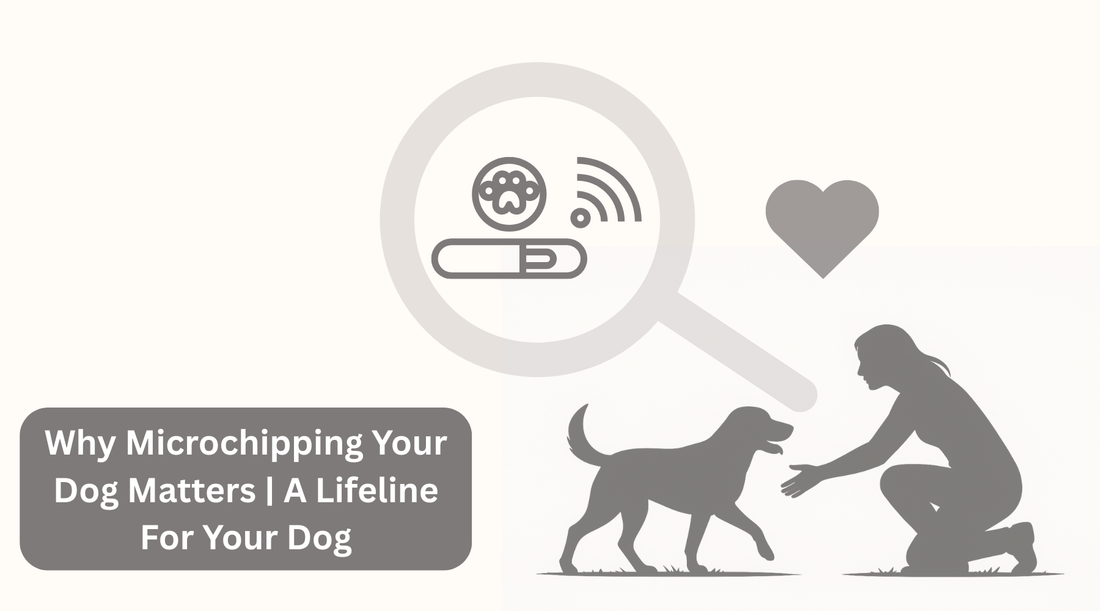When it comes to keeping dogs safe, microchipping is one of the most reliable tools we have. Collars and ID tags are still important, but they can break, fade, or fall off. A microchip, on the other hand, is permanent, unique, and designed to protect your dog for life.
What is a Microchip?
A microchip is a tiny implant, about the size of a grain of rice, placed just under your dog’s skin between the shoulder blades. Each chip carries a unique identification number that links to a registry with the owner’s contact information.
When a vet or shelter scans the chip, the number connects your dog back to you—making it one of the most reliable forms of permanent identification. With proper registration, a lost dog can be quickly reunited with their family.
10 Reasons to Microchip Your Dog
Microchipping is simple, safe, and affordable—but the benefits last a lifetime. Here’s why every dog should have one:
1. Permanent Identification
Unlike collars or tags, a microchip can’t be lost, removed, or damaged.
2. Higher Return-to-Owner Rates
Studies show microchipped dogs are more than twice as likely to make it back home.
3. Proof of Ownership
A registered chip provides legal protection in case of disputes.
4. Required for International Travel
Many countries won’t allow entry without a registered microchip.
5. Zero Maintenance
No batteries or charging needed—the chip works for your dog’s entire life.
6. Small and Safe
About the size of a grain of rice, implanted in seconds, and virtually painless.
7. Affordable Protection
Usually a one-time cost between $15–$60.
8. Widely Recognized
Most vets, shelters, and rescues automatically scan for chips.
9. Standardized ID Number
Unique identification codes are registered in global databases.
10. Quick Scanning
Shelters and clinics can read the chip in just seconds, speeding up reunions.
Why Checking the Chip Matter
A microchip only works if it’s properly registered and kept up to date. Even the best technology can fail if the details behind it aren’t accurate. Here are the main reasons to check your dog’s chip regularly:
1. Database Changes
Some microchip companies merge, close, or shift registries—meaning your dog’s info could get lost in the shuffle.
2. Outdated Contact Information
If your phone number or address has changed, no one can reach you when your dog is found.
3. Chip Functionality
Chips can occasionally stop working or migrate under the skin. A quick scan at the vet ensures it’s still active and easy to find.
👉 Tip: Ask your vet or local shelter to scan your dog’s microchip once a year and confirm your registration details online.
How Microchips Help Reunite Dogs and Owners
When a microchip is implanted and registered, the recovery process is simple and effective:
1. Scan the Dog
A shelter, vet, or animal control officer uses a handheld scanner to detect the microchip.
2. Locate the Registry
Databases such as the AAHA Pet Microchip Lookup identify which registry holds the ID number.
3. Contact the Registry
The registry provides the owner’s details linked to that microchip.
4. Notify the Owner
The shelter or clinic reaches out using the registered phone number or email.
5. Reunite the Dog
Once ownership is confirmed, the lost pet is safely returned home.
A microchip can’t prevent a dog from getting lost—but it dramatically increases the chances of a happy reunion.
Why Microchipping Your Dog Matters
Microchipping is one of the most reliable ways to keep your dog safe. Small, affordable, and permanent, a microchip provides a unique ID that links your dog back to you—dramatically improving the chances of a quick reunion if your dog ever gets lost.
But a microchip only works if it’s properly registered and up to date. Regularly checking your dog’s chip ensures your contact information is current and that the chip itself is functioning. Most vets and shelters recommend scanning your dog’s microchip at least once a year.
With a properly registered microchip, you’re giving your dog a lifeline: a simple, stress-free way to help them get home safely. Don’t rely on collars or tags alone—make sure your dog has a permanent ID that will protect them for life.

